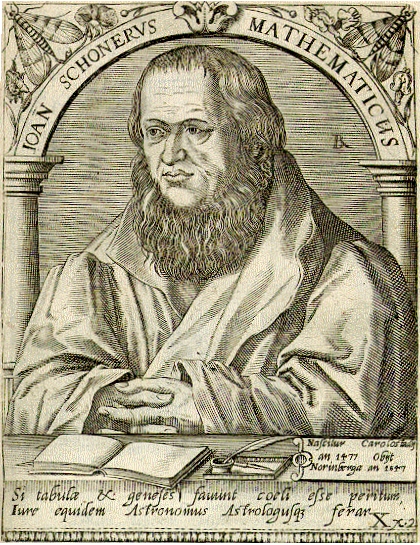<Back to Index>
- Astronomer Johannes Schöner, 1477
- Painter Alexander Adriaenssen, 1587
- King of Naples René of Anjou, 1409
PAGE SPONSOR

Johannes Schöner (January 16, 1477 in Karlstadt am Main – January 16, 1547 in Nürnberg) (aka, Johann Schönner, Jean Schönner, Joan Schoenerus) was a renowned and respected German polymath. It is best to refer to him using the usual 16th century Latin term "mathematicus", as the areas of study to which he devoted his life were very different from those now considered to be the domain of the mathematician. He was a priest, astronomer, astrologer, geographer, cosmographer, cartographer, mathematician, globe and scientific instrument maker and editor and publisher of scientific tests. In his own time he enjoyed a European wide reputation as an innovative and influential globe maker and cosmographer and as one of the continents leading and most authoritative astrologers. Today he is remembered as an influential pioneer in the history of globe making and as a man who played a significant role in the events that led up to the publishing of Copernicus' "De revolutionibus" in Nürnberg in 1543.
Schöner was born on January 16, 1477 in Karlstadt am Main in Lower Franconia. As with most Renaissance scholars nothing is known about his parents or his early life. All that is known is that he had a brother, Peter, to whom he addressed his “Arzneibuch” in 1528. Quite detailed information for Schöner’s adult life, at least up to 1506, has been preserved in his own marginalia in his copy of Regiomontanus' printed Ephemerides, which he used as a diary. He matriculated at the University of Erfurt in the winter semester 1494/5 and graduated Baccalaureus on 21 March 1498. He was appointed to a position in the school in Gemünden on 22 February 1499 and ordained as a Catholic priest in the Bishopric of Bamberg on the 13th June 1500. On the 2nd February 1500 he moved to Bamberg and was appointed chaplain in Hallstatt near Bamberg on the 18th April 1500. His next appointment was as vicar in his hometown Karlstadt from the 4th June 1504. Between the 4th May and the 29th October 1506 he was again in Bamberg before he returned to Karlstadt. His diary also informs us that he entered a relationship with Kunigunde Holocher in 1499, with whom he had three children: a son Johannes born on the 1st February 1502, a daughter Sibilla born on the 12th June 1503 and a second son Vitus born on the 21st November 1504.
He was a pupil of the map maker Martin Waldseemüller. A copy of the Waldseemüller map which once was owned by Schöner is now in possession of the Library of Congress.
No diary exists after 1506, and up to 1515 there are only indirect traces of Schöner's existence in the financial records of the bishopric and in the correspondence of Lorenz Beheim (?1457 - 1521), who after 24 years in Rome as chamberlain to Pope Alexander IV had returned to Bamberg in 1505 as a canon of the cathederal.
In 1526, he was called to Nürnberg as the first professor of mathematics at the newly founded gymnasium Aegidianum, a post he held till one year prior to his death. At the same time, he converted to Protestantism and married.
Already in Bamberg, he owned his own printing company and published many maps and globes. The very first printed globe of the sky was made in his workshop in 1515. He made another globe in 1520.
Schöner had also made still unpublished data of Mercury observations from Walther available to Copernicus, 45 observations in total, 14 of them with longitude and latitude. Copernicus used three of them in "De revolutionibus", giving only longitudes, and falsely attributing them to Schöner. The values differed slightly from the ones published by Schöner in 1544.
In 1538, Georg Joachim Rheticus, a young professor of mathematics at Wittenberg, stayed for some time with Schöner who convinced him to visit Nicolaus Copernicus in Frauenburg. In 1540, Rheticus dedicated the first published report of Copernicus work, the Narratio prima, to Schöner. As this was well received, Copernicus finally agreed to publish his main work, and Rheticus prepared Copernicus' manuscript for printing.
In Nürnberg, Schöner published in 1544 the astronomical observations of Regiomontanus and Walther, as well as manuscripts of Regiomontanus, which had been in the hand of Walther, as Observationes XXX annorum a I. Regiomontano et B. Walthero Norimbergae habitae, [4°, Norimb. 1544].